
Terrace Farming Purpose, Benefits, And Common Types
Terrace farming is an efficient and often the only solution for hilly farmlands. Yet, its advantages are multifold. The importance of terrace farming goes far beyond cultivating lands that are not suitable for agriculture otherwise. Furthermore, terrace farming prevents soil erosion and contributes to soil conservation. Nowadays, the method allows growing versatile crops, and its management is more comfortable with online agricultural software.
What Is Terrace Farming?
Terracing is an agricultural practice that suggests rearranging farmlands or turning hills into farmlands by constructing specific ridged platforms. These platforms are called terraces.
The essential (and distinguishing) feature of terracing agriculture is excavating and moving topsoil to form farmed areas and ridges. The trick is that water flows down to lower platforms when the upper ones are full. This helps prevent slope erosion by distributing water more or less evenly across the hill rather than letting it flow all the way to the foot.
Most Common Types Of Terraces
Farmed areas in agricultural terracing are either level or tilted, depending on the soil infiltration properties. If soil infiltration is sufficient, they are made level. Typically, outlets are not required, too.
The most popular terracing types in farming are broad-base, narrow-base, and grassed back-slope. Their choice depends on how steep the hill is. Correspondingly, not all the types imply farming of all terrace slopes.
Broad-Base Terrace Farming
The farming technique is suitable for the gentlest hills, and terrace cultivation embraces all the slopes. For this reason, they should suit machinery needs, and the terrace spacing is typically equal to the number of machinery swaths. Crossing the ridges is prohibited – the equipment is supposed to move between the terraces through designated passages. Broad-base terracing is applicable on slopes up to 8%.
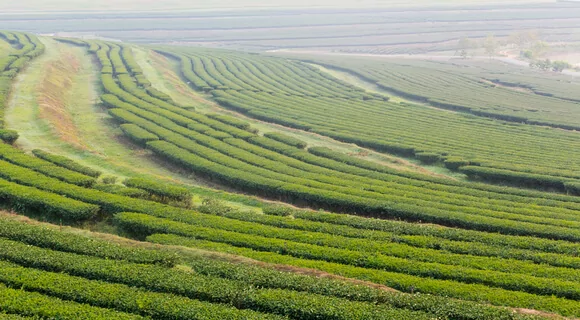
Grassed Back-Slope Terrace Farming
The farming type is an example of perennial terracing. As the name suggests, the back slope cover is a perennial grass. In the given terrace farming technique, the back slope is not cultivated, unlike the main part. Typically, the main part includes the soil taken from the downhill upwards, with further leveling for farming.
Narrow-Base Terrace Farming
A terrace of this type is another example of perennial terracing, but in this case, permanent vegetation covers both the front and back sides. These parts are not cultivated. Like with the grassed back slope, the earth is usually moved from downhill. Yet, this is the steepest terracing type, requiring less amount of earth for platforms than others.
Terrace Farming Systems
The commonly used terracing systems are bench, contour, and parallel terraces. Their names give an idea of their layout.
Bench Terracing
Bench systems in farming resemble benches or steps across the slope, with flat or almost flat farmed platforms arranged at regular intervals. Such regular arrangement is labor-consuming and suggests intensive soil disturbance. The slopes may consist of earth proper, covered with perennial vegetation, or may be fortified with stones.
Bench terracing in agriculture is most common for growing rice since bench terraces allow retaining water. For this reason, such a terracing layout is not suitable in the cases like:
- crops are sensitive to waterlogging, e.g., growing potatoes;
- lands are prone to sliding;
- frequent rains characterize weather patterns in the area.
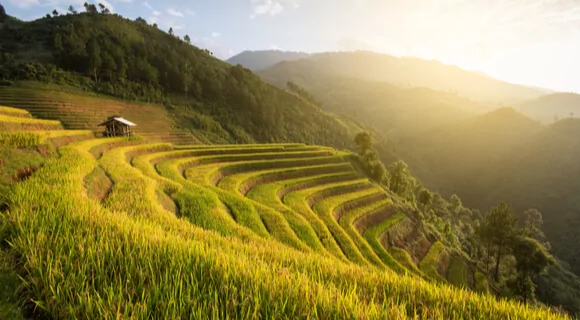
Contour Terracing
Like in contour strip farming, these terracing systems follow the relief contour. Terraces consist of point rows and grassed waterways. Even though such platforms require less input to arrange them, they are difficult for farming activities due to space irregularities.
Parallel Terracing
Parallel constructions are the easiest for farming activities, so they should be kept as parallel as possible. If the slope does not allow that, they are built through land-leveling operations. It facilitates machinery movement, yet it is labor-, cost-, and time-consuming. In this regard, sometimes it will make sense not to treat those parts but leave them under perennial cover or as grass waterways.
Manage your fields with high-resolution satellite images for the most accurate and timely changes detection!EOSDA Crop Monitoring
Benefits Of Terrace Farming
The technique is credited to ancient Incas, who developed the farming method of terracing in the Andes. Today, terracing is typical for mountainous rice paddies in Asia. Yet, terrace farming advantages make it a beneficial experience to borrow for any hilly terrains, both paddies or drylands, with various crops to grow.
So, why is terrace farming important in hilly areas? The benefits of terracing are quite numerous, which proves its importance for humans and nature. In particular, terrace agriculture:
- Increases farmability and land productivity of sloped fields.
- Contributes to water conservation: slows down and reduces water runoffs, improves rainwater harvesting.
- Prevents soil erosion by decreasing rill formations.
- Boosts soil conservation.
- Reduces sedimentation and water pollution. Water stays long enough for heavy particles to settle down and prevent downstream sedimentation and pollution of water bodies, but short enough not to harm crops.
- Increases food production by adjusting hilly land for farming.
- Adds to ecosystem diversity.
- specific machinery to push and level the soil;
- high labor and cost inputs;
- land disturbance that often requires additional treatment;
- hiring trained staff to arrange terraces;
- preliminary soil testing (slipping soils are not suitable).
What Is The Purpose Of Terrace Farming?
All terracing techniques allow farmers to retain or remove water and reduce the steepness of the hill. In fact, the purpose of terrace farming is to intercept water in a designated channel and remove it via constructed erosion-resistant ditches or subsurface pipe outlets. This proves the efficiency of terracing to stop erosion and contribute to soil conservation.
How Does Terrace Farming Help In Conserving Soil?
Terracing helps retain soil cover and fertility since water flows do not wash off the topsoil and nutrients.
So, what is terracing in soil conservation?
- The slope is no longer as steep as it initially was.
- Water runoffs are slower due to leveled areas.
- Water streams do not flow on the earth’s surface as they usually do on hilly lands. Water is either collected in channels or runs under the surface via outlets and pipes.
Farming on a terrace is an efficient soil conservation practice. However, it requires regular inspection and maintenance at the same time. Thus, in efficient terrace farming, it is essential to check the ridges and grass cover, improving where necessary. Another issue of the terracing practice is the sedimentation of channels, which is resolved with cleaning and planting buffer strips. Also, the outlets and pipes should be clean and free from vegetation residue and particles that may block them.
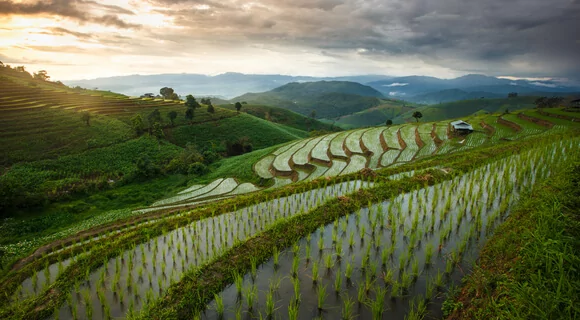
How Does Terracing Prevent & Reduce Soil Erosion?
Since water comes down through designated outlets, terracing prevents the formation of soil-eroding rills. How does terrace farming prevent soil erosion? In fact, terraces break the slope, splitting one big slope into several smaller ones, making it less steep, and the force of water due to gravitation is less destructive.
However, this is not the only way of terracing to prevent soil erosion. Additionally, vegetation on front and back slopes mitigates the risk of destruction by water and wind.
If a farmer sees visible signs of erosion or has decreased yields season by season, and the field elevation is uneven (sloped), it is worth opting for terracing to stop erosion and boost yields. Using our crop monitoring system for agricultural fields, farmers can get data on field elevation and how the productivity of the field has changed over time. It shows the trend of how the vegetation was developing over a selected period. With this information, a farmer can decide on productivity zones of the field and treat each zone differently (depending on the needs).
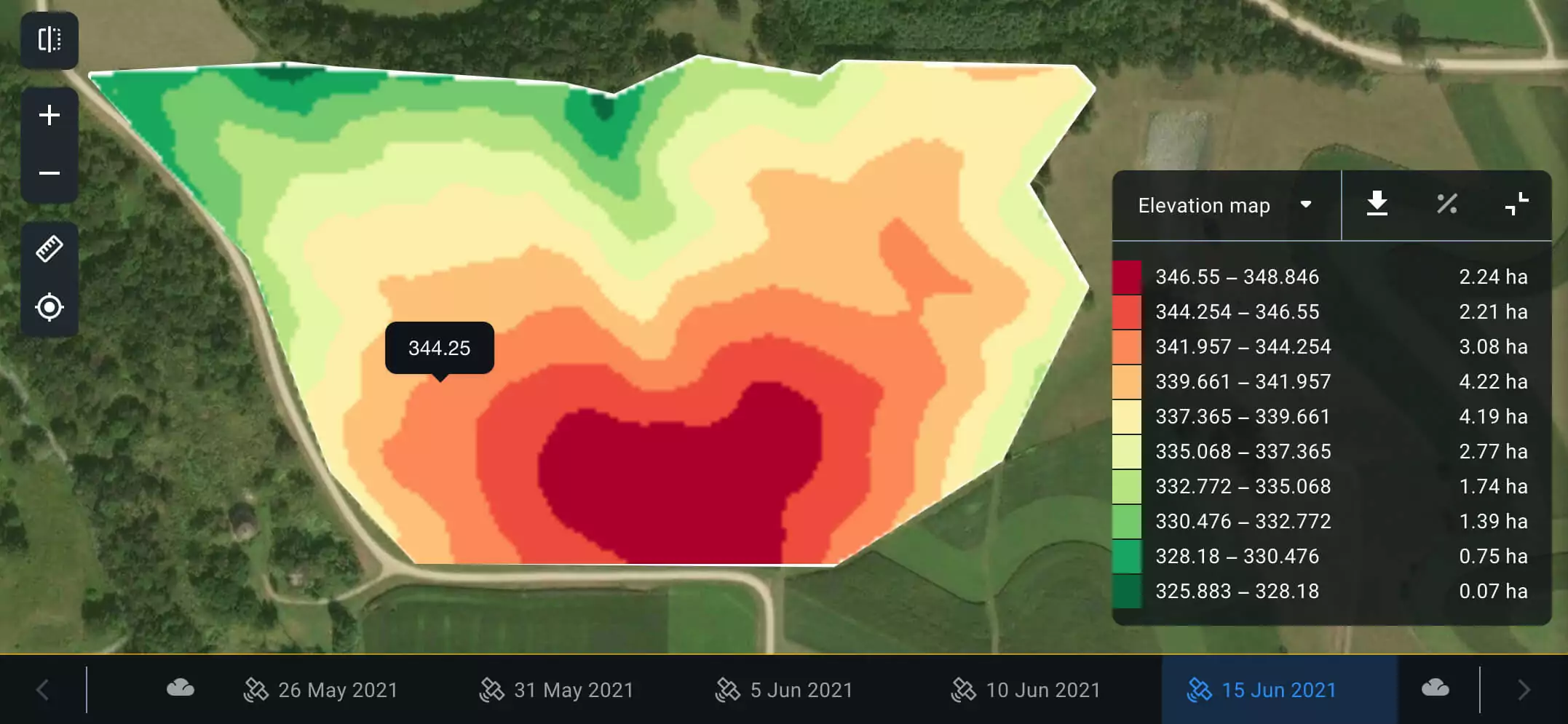
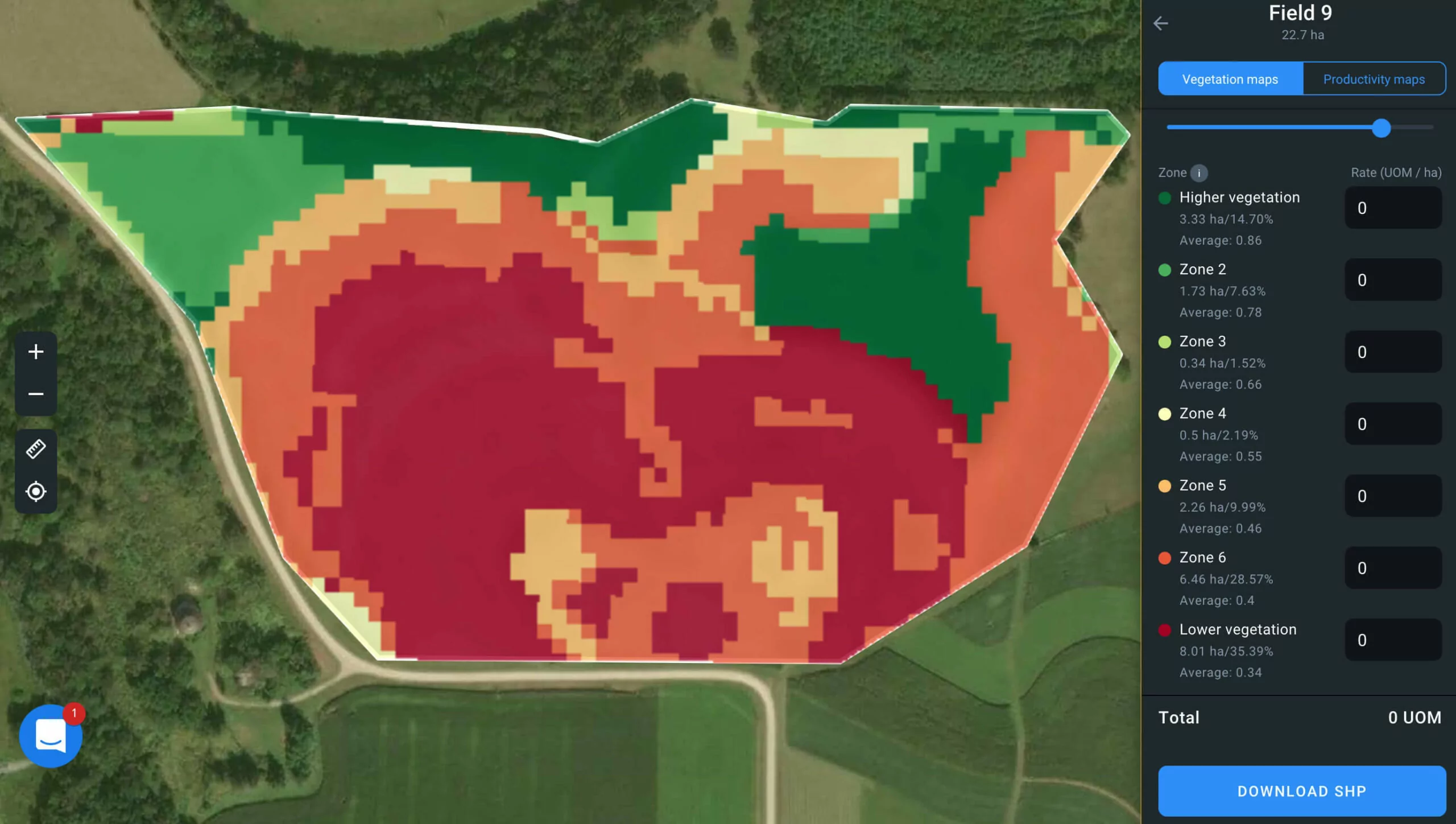
Crops Grown In Terrace Farming
The choice of species depends on their productivity in highlands and sensitivity to waterlogging since terraces tend to accumulate moisture. For example, rice grows in paddies, but its productivity drops on elevations higher than 375 m .
Nonetheless, terrace farming crops are rather diverse. These are grains, legumes, medicinal and culinary herbs, berries, nuts, fruits, vegetables, etc. In particular, examples of common crops farmed by terrace farming include:
- wheat,
- buckwheat,
- corn,
- rice,
- millets,
- saffron,
- black cumin,
- pulses,
- apples, etc.
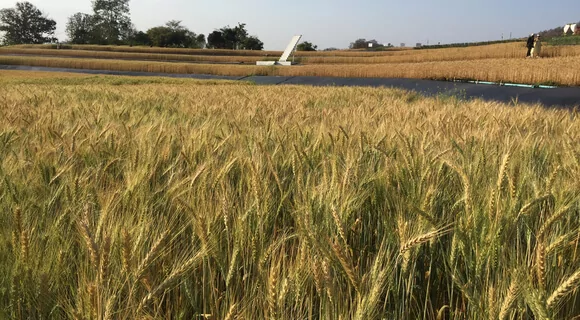
Is Terracing Sustainable?
Prevention or reduction of soil erosion, as well as soil conservation by terracing, allow using the terraced farmlands in the long run. It attests to the essential role of terracing in sustainable agriculture.
Even though terrace layout demands certain inputs and efforts, the advantages of terracing make it a promising practice. Modern terrace farming becomes easier to implement with satellite monitoring and online agricultural tools. EOSDA Crop Monitoring can become a reliable farming assistant in this regard, among the many more product capabilities. If you have any questions regarding our product, you are welcome to reach us via sales@eosda.com, and our team of experts will help you.
About the author:
Kateryna Sergieieva has a Ph.D. in information technologies and 15 years of experience in remote sensing. She is a Senior Scientist at EOSDA responsible for developing technologies for satellite monitoring and surface feature change detection. Kateryna is an author of over 60 scientific publications.
Recent articles

Analyze 2025 & Plan Your Best Year Yet: LandViewer Christmas Offer
It’s the most wonderful time of the year! The Christmas holidays are here, and so is your chance to analyze 2025 and plan a prosperous 2026 with more affordable Pro plans in LandViewer.

EOSDA Models Climate Change Impact On Sugarcane Yields
EOSDA modeled future temperature, rainfall, and other climate impacts on Veracruz sugarcane. The results help growers plan long-term adaptation strategies, including timing, varieties, and irrigation.

EOSDA LandViewer Black Friday Sale: Exclusive Offers & Giveaway
This Black Friday, LandViewer offers new users the chance to save on monthly plans, get extra months with yearly subscriptions, and participate in a free annual plan giveaway.